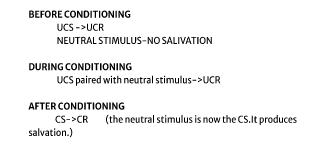The behaviorist approach -A-Level Psychology
The behaviorist approach rejected the vagueness of introspection and focused on observable events.
Classical conditioning: Ivan Pavlov(1927)
Classical conditioning is learned by association.It occurs when a neutral stimulus is consistently paired with an unconditioned stimulus to produce a conditioned response.
– investigated the salivary reflex in dogs, when he noticed that animals not only salivated when food was placed in their mouth but also reacted to the stimuli that coincided with the presentation of the foods e.g a food bowl. He explored the conditions under which type of learning this was most likely to occur.
UCS-the natural stimulus in any reflex
UCR-the natural response to the stimulus

A neutral stimulus which doesn’t trigger the UCR is presented shortly before the UCS.. After many pairings of NS+UCS , the NS is able to produce the same response in the absence of the UCS and the NS(bell) is now called the CS and it produces a CR.
Timing- if the neutral stimulus cannot be used to predict the unconditioned stimulus or the time interval between the two is too long then conditioning does not take place.
Extinction- Pavlov discovered that unlike the UCR the CR does not become permanently established.In the absence of the UCS it’s ability to produce the CR is lost.
Spontaneous recovery- Following extinction,if the CS and the UCS are paired together again, the link between them is made much more quickly.
Stimulus generalisation- Pavlov discovered that once an animal has been conditioned they will also respond to other stimuli that are similar to the CS.
Operant conditioning:Skinner(1938)
A form of learning in which behaviour is shaped and maintained by the consequences(reinforcement or punishment).If a behaviour is followed by a desirable consequence than that behaviour is more likely to occur again in the future.
Types of reinforcement-
Reinforcement is anything that strengthens a response.Both types of reinforcement increase the likelihood that the behaviour will be repeated.
1)Positive reinforcement occurs when behaviour produces a consequence that is pleasant.
2)Negative reinforcement occurs when a human avoids something unpleasant e.g switching an alarm off to avoid hearing the noise.
Schedules of reinforcement- although a continuous reinforcement schedule is most effective in establishing a response,a partial reinforcement schedule is more effective in maintaining the response and avoiding extinction.
Punishment-refers to the circumstance whereby a behaviour is followed by a consequence that is unpleasant.It decreases the likelihood of the behaviour recurring.
The skinner box investigated operant conditioning in rats.When the rat accidentally pressed the lever a food pellet fell into the cage.If the food pellets stop the rat presses thet lever a few more times then abandons it (extinction).
Evaluation:
Strengths of classical conditioning explanations- has led to the development of treatments for the reduction of anxiety associated with phobias e.g. systematic desensitization.This works by eliminating the learned anxious response and replacing it with another of relaxation.It has worked for arachnophobia.
Limitations of classical conditioning explanations- relationships between the CS and UCS tend to be more difficult to establish for some species than for others. Seligman(1970) suggested that animals are prepared to learn associations that are significant for survival rather than those that are not significant to survival.
Strengths of operant conditioning explanations- Skinner’s research was done through experimental methods with controlled conditions.By manipulating the IV we(consequences of behaviour) he was able to accurately measure the effects on the DV(rat’s behaviour).
Limitations of operant conditioning explanations- Skinner’s research involved the study of animals rather than humans meaning that the results tell us little about human behaviour.Critics reject Skinner’s disregard for free will.
The behaviorist approach is a theory of learning that focuses on observable behaviors and environmental stimuli. It suggests that all behavior, including human behavior, is learned through interactions with the environment and that it can be modified through rewards and punishments.
The key theorists of the behaviorist approach include Ivan Pavlov, B.F. Skinner, and John Watson.
Classical conditioning is a form of learning in which a neutral stimulus is paired with a stimulus that naturally elicits a response. Over time, the neutral stimulus becomes associated with the natural stimulus and can elicit the response on its own.
Operant conditioning is a form of learning in which behavior is modified through the use of rewards and punishments. Desired behaviors are reinforced through rewards, while undesired behaviors are discouraged through punishments.
The behaviorist approach suggests that language is learned through imitation and reinforcement. According to this theory, children learn language by imitating the speech they hear around them and receiving positive reinforcement when they use language correctly.
The behaviorist approach suggests that personality is largely shaped by environmental factors, such as the rewards and punishments that individuals receive for their behaviors. According to this theory, individuals develop personality traits that are reinforced by positive outcomes and discouraged by negative outcomes.
The behaviorist approach has had a significant impact on psychology as a field, particularly in the areas of learning, motivation, and behavior modification. Its emphasis on observable behaviors and the use of empirical methods to study them has helped to shape the way we understand human behavior.
You can apply the principles of the behaviorist approach in your studies by using rewards and punishments to reinforce desired behaviors. For example, you might reward yourself for completing a difficult assignment or punish yourself for procrastinating. You can also use the principles of classical and operant conditioning to help you learn and remember information more effectively.






Still got a question? Leave a comment
Leave a comment